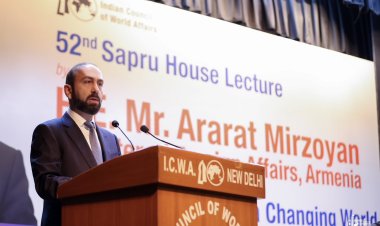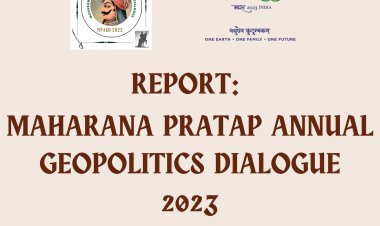Leveraging Science, Technology and Innovation to Boost India’s Soft Power
The article focuses on how the idea of STI as a soft power tool is premised on science and engineering diplomacy, which builds trust, bridges gaps between countries and can also work outside the realm of politics and it also recommended how to increase the country’s soft power through STI.

Analysis
By Priyank Mishra
In recent years, the utility of hard power, which is the exercise of influence through coercion and intimidation has increasingly come under question. And now soft power, which is the power of cultural attractions, political values, and persuasion is becoming fundamental to a nation’s ability to navigate the modern world.
Among several resources of India’s soft power, science, technology and innovation (STI) has emerged as a key stratagem in the last few decades. This is now evident as Indians and people of Indian origin have risen to pre-eminence, heading top MNCs, at the forefront of scientific breakthroughs and winning various elite scientific prizes. Further, achievements of the Indian IT industry and engineering groups such as Tata, Reliance, and Adani; and the global fame of the Indian Institutes of Technology (IITs) have impassioned a new image of India.
The idea of STI as a soft power tool is premised on science and engineering diplomacy, which builds trust, bridges gaps between countries and can also work outside the realm of politics.
As soft power is more intangible than hard power, it would be difficult to bring direct empirical evidence between a country’s higher standing in science and technology; and its improved soft power. However, when we analyze the correlation between innovativeness and S&T output (Using data of the Global Innovation Index 2022) and soft power (based on the 2019 Soft Power 30 Index), we find countries such as the USA, UK, Germany and Japan are not only highly innovative and have higher S&T output and but also are strong Soft Powers. In contrast, countries such as China and Israel, although having high innovation and S&T strength, do not have corresponding soft power. India, despite having made significant investments in the STI ecosystem in the last few decades, is conspicuously absent from the 2019 Soft Power 30 Index while China figures at number 27. Also in some other similar soft power rankings such as Pew Global Attitudes Survey and ranking by the British magazine Monocle, India does not figure prominently. So it seems, while culture, diplomacy, and universalistic values help in acquiring soft power; STI can also play a role if strategic orientation is accorded to it.
It's true that the methodology of these soft power rankings includes several measures such as the attractiveness of a country’s economic model, political institutions, diplomatic network, and the reputation of their education system among others. Thus due to the high level of subjectivity, it is difficult to devise an unbiased ranking of a country’s soft power. Yet as the evidence shows, science and technology, which have been the driving force behind so much in the modern world, do not figure adequately in the Indian approach to build and advance international relations.
Here are some recommendations to increase the country’s soft power through STI.
First, India should concentrate on forging MoUs of Indian technical institutes with top foreign institutes and industries that excel in specific areas. Although, India has bilateral S&T cooperation agreements with several countries. However, they lack strategic orientation. The student and faculty exchange programs are not pre-thought and hardly any foreign faculty and students of top universities come to India for research.
So the aim should be to enhance mutually beneficial collaboration among scientists and engineers, between individual businesses, and among organizations such as research institutions and industry.
Individual collaborations sometimes bring lasting personal and organizational relationships which can outlive political cycles. India itself has been a big beneficiary of such collaborations in the past. Soon after the Second World War, Bhabha approached his former colleagues in Europe for help in creating a world-class nuclear research establishment in India. And despite the cold war rivalry which had already riven the scientific community, many of his friends honored Bhabha’s requests.
At the organizational level, with 161 Institutes of National Importance including 23 IITs, 54 central universities, 38 CSIR labs and several other central and state-level institutes, India is well-placed to use its STI infrastructure to leverage international influence through building and maintaining trusted partnerships. Here the focus has to be on pursuing complementary targeted research and forging strategic cooperation keeping short-term and long-term national priorities in mind. For example, the collaboration between the start-up of an IIT research park with Taiwan Semiconductor Manufacturing Company (TSMC) which is the world's leading semiconductor chip and integrated circuit manufacturer, can fetch us the most-advanced semiconductor technology, the 3 nanometres (nm) and the 5nm, which will be a huge boost to our recent push in indigenous chip making. When it comes to the latest wireless communication engineering, negotiating collaborative agreements with Sweden would be ideal. Similarly, Indian institutes can extend their expertise in foreign countries, especially in South Asia, Africa and Latin America. In this regard, setting up foreign campuses of IITs can substantially enhance the currency of Indian S&T internationally.
Second, it is a hard but real fact that only a few Indian universities do quality research and very few journals of repute are published in India. The unfriendly environment triggered by decades of rote learning, lack of scientific enquiry, and neglect of primary and secondary education has led to an enervating brain drain of bright Indian minds to Western research centers. As ultimately foreign collaborations are also on a reciprocal basis and if none of our institutes figure in the top world universities rankings, why would someone want to collaborate with us?
Thus there is an urgent need to produce high-quality engineers and scientists in India. For this, far-reaching reforms to the education system and scientific bureaucracy would be required. New Education Policy 2020, Professor of Practice, and GIAN are some of the recent laudable steps that can substantially enhance academic standards and raise national scientific and technological capacity to the next level of innovation, transformation, and skill development. Consistent funding is required for meaningful and long-term research and so the need for private investment becomes inevitable. Already public-private partnership (PPP) model has been roped in for setting up 20 new Indian Institutes of Information Technology(IIITs). This can be further extended to other Indian institutes for the development of world class R&D infrastructure in India.
Third, as the experience world over shows, there are few S&T clusters with the highest density of inventors and scientific authors. In these clusters, a shared ecosystem involving a diverse set of actors from academia, industry and government exists which fosters high-end innovation and research. In the recently released Global Innovation Index 2022 where India has improved its rank from 81st(2015) to 40th(2022), there are four such clusters in India, out of the world’s top 100. The government has already recognised the importance of the cluster approach and six S&T clusters have been established in Delhi-NCR, Hyderabad, Pune, Jodhpur, Bengaluru, and Bhubaneswar. We need to further augment this cluster approach by linking our top research facilities with industries for nurturing innovation across the length and breadth of the country.
Disclaimer: This paper is the author's individual scholastic contribution and does not necessarily reflect the organization's viewpoint.
Priyank Mishra is a Senior Research Fellow in Discipline of Electrical Engineering, Indian Institute of Technology, Indore.
























